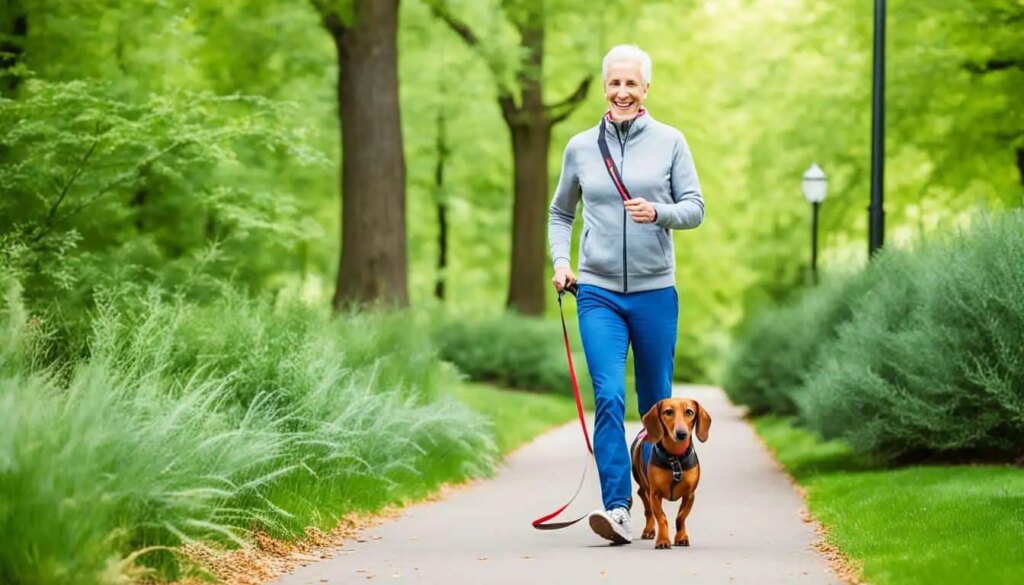“Walking is a man’s best medicine.” – Hippocrates
Your Dachshund may be small in size, but don’t be fooled by their stature. These dogs possess surprising energy levels that need to be properly channeled. Regular walks are not just a leisurely activity; they are essential for the overall health and well-being of your Dachshund. Walking provides them with much-needed exercise, helps with weight management, promotes muscle and joint health, and stimulates their mind.
In this article, we will explore why walking is necessary for Dachshunds and the benefits it brings to their overall health and happiness. Whether you’re a seasoned Dachshund owner or considering bringing one into your home, understanding the importance of exercise is key to ensuring a fulfilling life for your furry friend.
Key Takeaways:
- Regular walks are essential for the overall health of your Dachshund, providing physical exercise and mental stimulation.
- Walking helps with weight management, promotes muscle and joint health, and reduces the risk of obesity-related health issues.
- Dachshunds have surprising energy levels, making regular exercise necessary to prevent boredom and behavior problems.
- The exercise needs of Dachshunds vary based on their age and energy levels, with puppies requiring shorter, frequent walks, and adults needing longer walks to satisfy their energy demands.
- While walking is important, there are also safe indoor activities and enrichment options to keep your Dachshund mentally stimulated and physically active.
Is it necessary to walk a Dachshund?
Exercise for Health: Dachshunds, despite their size, possess surprising energy levels. Regular walks are essential to meet their exercise requirements and promote overall health and well-being.
Walking Your Dachshund daily not only provides physical exercise but also contributes to weight management, strengthens their muscles and joints, and offers mental stimulation and stress relief. Regular walks help prevent weight gain and obesity, ensuring your Dachshund maintains a healthy body condition. Additionally, walking promotes muscle and joint health, reducing the risk of injury and arthritic conditions. It also stimulates their mind, preventing boredom-related issues and promoting mental well-being.
Age and energy levels affecting exercise needs: The exercise needs of Dachshunds vary based on their age. Puppies have boundless energy and require shorter, more frequent walks to meet their energy demands. As they grow into adulthood, longer walks become necessary to satisfy their energy levels. By providing adequate exercise at their developmental stages, you can establish healthy habits that will benefit your Dachshund throughout their life.

Exercise is vital for the overall health and happiness of your Dachshund. Regular walks offer numerous physical and mental benefits, ensuring they lead a fulfilling and active lifestyle. In the next section, we will explore the specific benefits of regular walks for your Dachshund, including the prevention of back problems and the importance of a mixed exercise regime.
Comparison of Dachshund Exercise Requirements
| Age | Exercise Requirements |
|---|---|
| Puppy (up to 6 months) | Short, frequent walks |
| Adult (6 months and above) | Longer walks, satisfying energy needs |
The Benefits of Regular Walks for Your Dachshund
Exercise for Health: Dachshunds, despite their size, possess surprising energy levels. Regular walks not only provide essential physical exercise but also contribute to their overall health and well-being. Let’s explore the benefits of walking your Dachshund:
Preventing Back Problems in Dachshunds Through Exercise
Dachshunds are prone to back problems due to their elongated spine. However, regular walks can help strengthen their core muscles, which provide support to their spine. By engaging in low-impact exercise, such as walking, Dachshunds can reduce the risk of developing serious back issues and maintain a healthy posture.
Building Muscle Tone and Body Condition
Walking is a great way to build muscle tone and improve the overall body condition of your Dachshund. As they walk, their muscles are engaged and strengthened, leading to increased endurance and agility. This not only contributes to their physical well-being but also enhances their overall athletic performance.
The Importance of a Mixed Exercise Regime
While regular walks are beneficial, it’s essential to incorporate a mixed exercise regime for your Dachshund. On-lead walks provide structured exercise, but off-lead activities allow them to explore their environment and activate their natural instincts. A combination of both types of exercise ensures that your Dachshund gets the physical and mental stimulation they need for optimal health.

Creating Safe Indoor Activities for Your Dachshund
While outdoor walks are important for your Dachshund’s exercise routine, there are times when going outside may not be feasible. During these moments, it’s crucial to provide your furry friend with safe indoor activities that keep them mentally stimulated and physically active. Indoor enrichment is an effective way to ensure your Dachshund maintains a healthy lifestyle even when they can’t experience the great outdoors.
Dachshunds, despite their small size, possess surprising energy levels. Regular walks help provide the necessary physical exercise that aids in weight management, promotes muscle and joint health, stimulates their mind, and offers stress relief. However, walks offer more than just physical benefits; they also provide mental stimulation and the opportunity to explore, reducing boredom-related issues in your pet.
When incorporating indoor activities into your Dachshund’s routine, it’s essential to consider their age and energy levels. Puppies require shorter, frequent walks to help burn off their excess energy and maintain their overall well-being. On the other hand, adult Dachshunds have higher energy demands and require longer walks to satisfy their exercise needs effectively.
To cater to your Dachshund’s exercise alternatives and indoor enrichment, there are various options available. Puzzle toys, for example, are an excellent way to engage your pet’s mind and keep them occupied. These toys usually involve hiding treats or challenging them to solve a puzzle to access a reward. In addition to puzzle toys, you can also create obstacle courses using everyday items found around the house. This interactive playtime provides mental stimulation, encourages problem-solving skills, and helps maintain your Dachshund’s physical fitness.
Introducing indoor activities and enrichment options ensures that your Dachshund remains happy and healthy even in situations where outdoor exercise isn’t possible. By incorporating puzzle toys and obstacle courses into their routine, you can keep them mentally stimulated and physically active, preventing boredom and its associated behavioral issues. Remember, a mix of physical and mental exercise is essential to provide a well-rounded and enriching lifestyle for your beloved Dachshund!
Conclusion
In conclusion, regular exercise is vital for the health and well-being of your Dachshund. Walking provides numerous benefits, including physical exercise, weight management, and muscle and joint health. It also stimulates their mind, reduces stress, and prevents boredom-related issues.
When determining the frequency of walks for your Dachshund puppy, it is important to consider their age and energy levels. Puppies require shorter, more frequent walks to accommodate their growing bodies and higher energy levels. On the other hand, adult Dachshunds need longer walks to satisfy their energy demands and provide sufficient mental and physical stimulation.
While walks are essential, there are alternative ways to provide enrichment and ensure a healthy lifestyle for your Dachshund, especially when outdoor walks are not feasible. Puzzle toys, interactive games, and obstacle courses are great indoor activities that promote mental stimulation and physical exercise.
To maintain a healthy Dachshund lifestyle, it is important to establish a consistent exercise routine that includes regular walks and other enrichment activities. Additionally, providing a balanced diet, regular vet check-ups, and maintaining good hygiene practices are key best practices for ensuring the overall well-being of your Dachshund.
